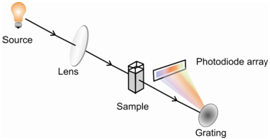Photodiode Array Spectrometer:
Within a photodiode array instrument, also known as a multi-channel instrument, the radiation result from the source is focused straight on the sample. This permits the radiations of all the wavelengths to concurrently fall on the sample. The radiation coming out of the sample after absorption (if any) is then made to fall on a reflection grating. The schematic arrangement of a diode array spectrometer is provided in Figure.

Figure: Schematic diagram for a photodiode array spectrometer
The grating disperses all the wavelengths concurrently. These then fall on the array of the photodiodes arranged side via side. By this way the intensities of all the radiations within the range of the spectrum are measured in one go. The benefits of such instruments are in which a scan of the whole range could be accomplished in a short time.
It was described earlier that UV-VIS spectrometry could be used for qualitative and quantitative determinations of the analyte. A quantitative determination is based on the relationship among the absorption of radiation and concentration of the analyte. Now let us learn about this relationship and other applications.